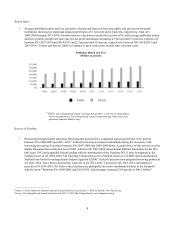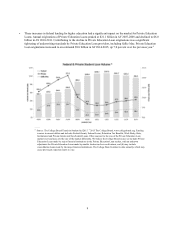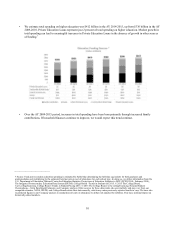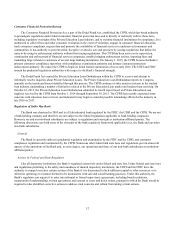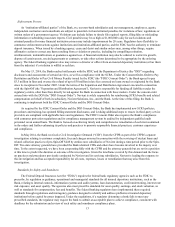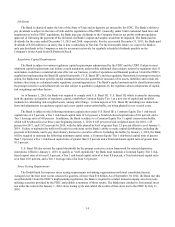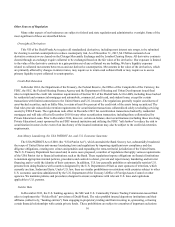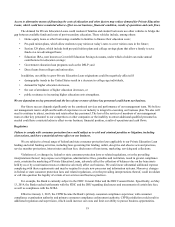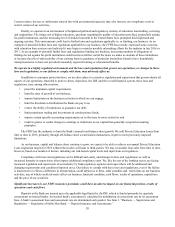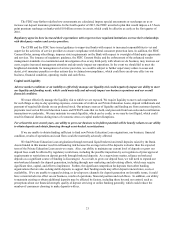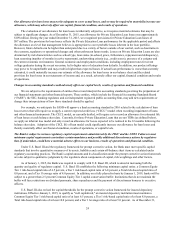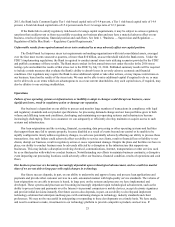Sallie Mae 2015 Annual Report Download - page 20
Download and view the complete annual report
Please find page 20 of the 2015 Sallie Mae annual report below. You can navigate through the pages in the report by either clicking on the pages listed below, or by using the keyword search tool below to find specific information within the annual report.18
Item 1A. Risk Factors
Economic Environment
Economic conditions could have a material adverse effect on our business, results of operations, financial condition and
liquidity.
Our business is significantly influenced by economic conditions. Economic growth in the United States remains uneven.
Employment levels in the United States are often sensitive not only to domestic economic growth but to the performance of
major foreign economies and commodity prices. High unemployment rates and the failure of our in-school borrowers to
graduate are two of the most significant macroeconomic factors that could increase loan delinquencies, defaults and
forbearance, or otherwise negatively affect performance of our existing education loan portfolios. Since 2009, the
unemployment rate of 20-24 year old college graduates has been higher than in prior years. It reached a high of 13.3 percent in
2011 and declined to 3.8 percent in December 2015. Likewise, high unemployment and decreased savings rates may impede
Private Education Loan originations growth as loan applicants and their cosigners may experience trouble repaying credit
obligations or may not meet our credit standards. Consequently, our borrowers may experience more trouble in repaying loans
we have made to them, which could increase our loan delinquencies, defaults and forbearance. In addition, some consumers
may find that higher education is an unnecessary investment during turbulent economic times and defer enrollment in
educational institutions until the economy improves or turn to less costly forms of secondary education, thus decreasing our
education loan application and funding volumes. Higher credit-related losses and weaker credit quality negatively affect our
business, financial condition and results of operations and limit funding options, which could also adversely impact our
liquidity position.
Competition
We operate in a competitive environment. Our product offerings are primarily concentrated in loan products for higher
education and deposit products for online depositors. Such concentrations and the competitive environment subject us to
risks that could adversely affect our financial position.
The principal assets on our balance sheet are Private Education Loans. At December 31, 2015, approximately 69 percent
of our assets were comprised of Private Education Loans and this concentration will likely increase. We compete in the Private
Education Loan market with banks and other consumer lending institutions, many with strong consumer brand name
recognition and greater financial resources. We compete based on our products, origination capability and customer service. To
the extent our competitors compete more aggressively or effectively, we could lose market share to them or subject our existing
loans to refinancing risk.
Competition plays a significant role in our online deposit gathering activities. The market for online deposits is highly
competitive, based primarily on a combination of reputation and rate. Increased competition for deposits could cause our cost of
funds to increase, with negative impacts on our financial returns.
In addition to competition with banks and other consumer lending institutions, the federal government, through the Direct
Student Loan Program (“DSLP”), poses significant competition to our Private Education Loan products. The availability and
terms of loans the government originates or guarantees affect the demand for Private Education Loans because students and
their families often rely on Private Education Loans to bridge a gap between available funds, including family savings,
scholarships, grants and federal and state loans, and the costs of post-secondary education. The federal government currently
places both annual and aggregate limitations on the amount of federal loans any student can receive and determines the criteria
for student eligibility. Parents and graduate students may obtain additional federal education loans through other programs.
These federal education lending programs are generally adjusted in connection with funding authorizations from the U.S.
Congress for programs under the Higher Education Act of 1965 (“HEA”). The HEA’s reauthorization is currently pending in the
U.S. Congress and a vote may occur in 2016. Increased funding authorizations or federal education loan limits contained in any
reauthorization could decrease demand for Private Education Loans.


